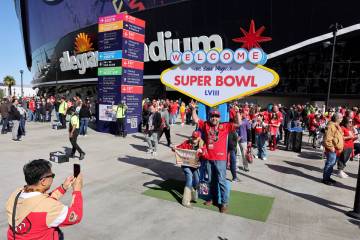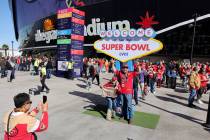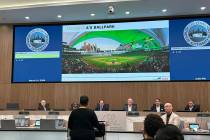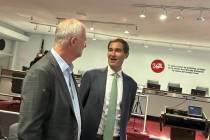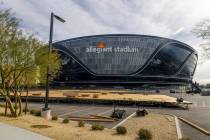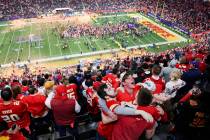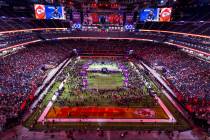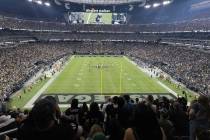Sandoval wants to know who pays for roads leading to proposed stadium
Gov. Brian Sandoval on Monday asked who would pay for the necessary upgrades to freeways and streets leading to a 65,000-seat domed football stadium proposed by Las Vegas Sands Corp., Majestic Realty and the Oakland Raiders.
With a site recommendation anticipated as soon as Aug. 25 among four potential finalists, Sandoval said that he wants to know how traffic would be impacted by games, concerts and other big-ticket events held at the proposed stadium.
“This is serious,” Sandoval said Monday during a meeting held by the Nevada Department of Transportation’s board of directors.
“I’m going to need the information in a very short time period to see what needs to be considered if, indeed, a stadium site is recommended,” said Sandoval, who serves as chairman of the NDOT board. “There are a lot of things to consider, but I don’t want to suddenly have an item on our agenda that says we need to make a $150 million improvement to the intersection.”
If a stadium is ultimately approved, the developers would perform the traffic study and pay for any necessary infrastructure, said Steve Hill, chairman of the Southern Nevada Tourism Infrastructure Committee.
Those costs are included in the stadium cost project, estimated at $1.7 billion to $2.1 billion, Hill said through a spokeswoman, without providing specifics. The developers have proposed a public-private partnership to build the stadium, which would include between $550 million and $750 million in public funds through hotel room taxes.
Representatives for Sands and Majestic have previously said that the costs of road improvements are included in the total package.
The Raiders have promised to pursue relocation to Las Vegas if a financing plan is approved by state lawmakers. The stadium also would host UNLV football games and events that are too big for existing Las Vegas arenas.
“Knowing the stadium location is key to determining what infrastructure is needed and how much it would cost, as it is site-specific,” Hill said, adding that the range is “quite large.”
Sandoval raised the issue about potential traffic impacts caused by the proposed stadium during the state Transportation Board’s discussion of an upcoming $5.3 million study of Southern Nevada’s freeway system. The panel unanimously agreed to conduct the study, which will determine traffic projections through 2040 in an attempt to prioritize pending transit projects.
The report, due next year, will not include a traffic analysis of the stadium, said John Terry, assistant director of engineering for NDOT.
The 11-member Southern Nevada Tourism Infrastructure Committee is expected to review its options for stadium sites on Aug. 25.
The Bali Hai Golf Club, a 140-acre golf course on Las Vegas Boulevard, just south of Russell Road, has emerged as the leading contender favored by the developers, government officials and gaming industry leaders.
The Clark County Department of Aviation and Federal Aviation Administration will soon determine the suitability of a stadium for the site, which sits at the west end of McCarran International Airport’s primary east-west runways.
County officials and representatives for the developers said that other potential stadium sites continue to be studied, including: the 113-acre Wild Wild West truck plaza on Tropicana Avenue; a 62-acre area on Russell Road, west of Interstate 15 and the Mandalay Bay hotel-casino; and Cashman Center in downtown Las Vegas.
Tom Skancke, a member of the state Transportation Board, said that at least three freeway interchanges along Interstate 15 would need to be improved for any of the potential stadium sites.
If the Rock in Rio location is selected, Skancke warned that adjustments may be needed at the ongoing $1 billion Project Neon, which calls for redesigning and adding traffic lanes to the Spaghetti Bowl in downtown Las Vegas.
“I think it’s important for the governor and for that committee to have an understanding of what the preliminary cost is going to be, and the timing,” Skancke said. “There may be sites that are probably more beneficial to the state Department of Transportation, but don’t work from the stadium perspective.”
The Review-Journal is owned by a limited liability corporation owned by the family of Sands chairman and CEO Sheldon Adelson.
Contact Art Marroquin at amarroquin@reviewjournal.com or 702-383-0336. Follow @AMarroquin_LV on Twitter.









